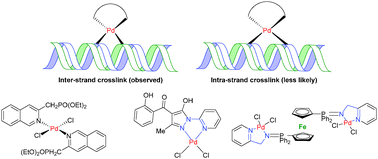Anti-cancer palladium complexes: a focus on PdX2L2, palladacycles and related complexes
Abstract
Much success has been achieved with platinum-based chemotherapeutic agents, i.e. through interactions with DNA. The long-term application of Pt complexes is thwarted by issues, leading scientists to examine other metals such as palladium which could exhibit complementary modes of action (given emphasis wherever known). Over the last 10 years several research groups have focused on the application of an eclectic array of palladium complexes (of the type PdX2L2, palladacycles and related structures) as potential anti-cancer agents. This review therefore provides readers with an up to date account of the advances that have taken place over the past several decades.


 Please wait while we load your content...
Please wait while we load your content...